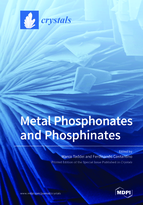Metal Phosphonates and Phosphinates
A special issue of Crystals (ISSN 2073-4352). This special issue belongs to the section "Inorganic Crystalline Materials".
Deadline for manuscript submissions: closed (30 April 2019) | Viewed by 35431
Special Issue Editors
Interests: carbon dioxide capture; materials chemistry; metal-organic frameworks; powder X-ray diffraction
Interests: layered materials; metal-organic frameworks; X-ray diffraction; catalysis
Special Issues, Collections and Topics in MDPI journals
Special Issue Information
Dear Colleagues,
We are pleased to announce the forthcoming “1st European Workshop on Metal Phosphonates Chemistry—Materials for Energy Applications and Beyond”, which will be held at the Energy Safety Research Institute (ESRI)—Swansea University, on 19 September, 2018, and to invite you to contribute to the present joint Special Issue of Crystals entitled “Metal Phosphonates and Phosphinates”.
Metal phosphonates and phosphinates (MPPs) are a class of crystalline metal–organic compounds characterized by a fascinating coordination chemistry and vast structural diversity. These materials display exceptional thermal and chemical stability, which makes them attractive for practical applications.
The scope of the “1st European Workshop on Metal Phosphonates Chemistry—Materials for Energy Applications and Beyond” is to bring together, for the first time, researchers from across Europe working in the field of metal phosphonates and phosphinates to discuss about the latest advancements and future directions. The scientific program covers a broad range of topics, such as synthesis, advanced methods for characterisation, porous materials, molecular magnetic compounds, energy storage and heterogeneous catalysis. For more information about the workshop, please visit the following link: https://europhosphonates.wordpress.com/
Submission of original research papers or reviews to this Special Issue of Crystals is open for both participants of the workshop and other researchers working in the field of metal phosphonates and phosphinates.
Dr. Marco Taddei
Dr. Ferdinando Costantino
Guest Editors
Manuscript Submission Information
Manuscripts should be submitted online at www.mdpi.com by registering and logging in to this website. Once you are registered, click here to go to the submission form. Manuscripts can be submitted until the deadline. All submissions that pass pre-check are peer-reviewed. Accepted papers will be published continuously in the journal (as soon as accepted) and will be listed together on the special issue website. Research articles, review articles as well as short communications are invited. For planned papers, a title and short abstract (about 100 words) can be sent to the Editorial Office for announcement on this website.
Submitted manuscripts should not have been published previously, nor be under consideration for publication elsewhere (except conference proceedings papers). All manuscripts are thoroughly refereed through a single-blind peer-review process. A guide for authors and other relevant information for submission of manuscripts is available on the Instructions for Authors page. Crystals is an international peer-reviewed open access monthly journal published by MDPI.
Please visit the Instructions for Authors page before submitting a manuscript. The Article Processing Charge (APC) for publication in this open access journal is 2600 CHF (Swiss Francs). Submitted papers should be well formatted and use good English. Authors may use MDPI's English editing service prior to publication or during author revisions.







